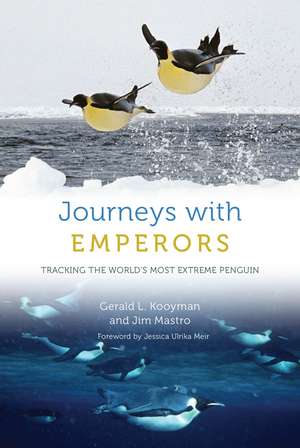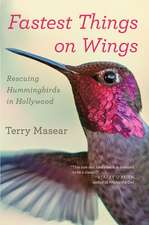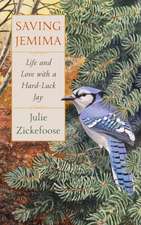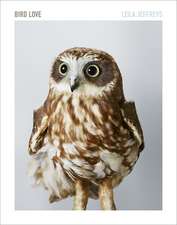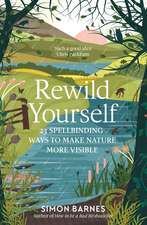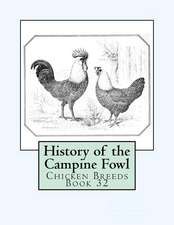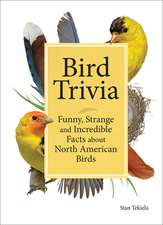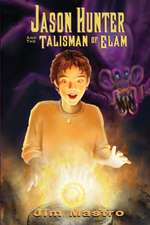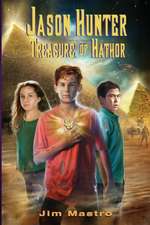Journeys with Emperors: Tracking the World's Most Extreme Penguin
Autor Gerald L. Kooyman, Jim Mastro Cuvânt înainte de Jessica Ulrika Meiren Limba Engleză Hardback – 29 noi 2023
With stunning photographs from the ice edge, a firsthand account of a researcher’s time in Antarctica and of the perilous journeys of the world’s largest penguin species: the iconic emperor.
Nearly all emperor penguin colonies are extremely remote; of the sixty-six known, fewer than thirty have been visited by humans, and even fewer have been the subject of successful research programs. One of the largest known emperor penguin colonies is found on a narrow band of sea ice attached to the Antarctic continent. In Journeys with Emperors, Gerald L. Kooyman and Jim Mastro take us to this far-flung colony in the Ross Sea, showing us how scientists gained access to it, and what they learned while living among the penguins as they raised their chicks.
The primary mission was to record the birds’ activities at sea, and the data revealed important aspects of emperor penguin behavior and physiology: for instance, that in the course of hunting for food, some of the penguins dive to depths of greater than five hundred meters (a third of a mile, which is deeper than for any other diving bird). The researchers also discovered that, crucially, most of the emperor’s life is actually spent at sea, with fledged chicks and adults making separate, perilous journeys through icy water. When chick nurturing is complete, the fledglings abandon the colony in large groups, heading north to the Southern Ocean. The adults leave at the same time, traveling one thousand kilometers eastward across the Ross Sea to a sea-ice sanctuary for molting. During this journey, they must gain enough weight to survive the month-long molt, when every feather is replaced and the birds cannot enter the water to feed. After the molt, many if not most return to the colony to breed once again. For the males, this means another fast—this time for 120 days as they incubate their eggs. The nearness of the colony to the ice edge spared the penguins the long, energy-draining march for which other colonies are well-known. It also allowed researchers to observe the penguins’ departures to and arrivals from their foraging journeys, as well as their dangerous interactions with leopard seals and killer whales.
Featuring original color photographs and complemented with online videos, Journeys with Emperors is both an eye-opening overview of the emperor penguin’s life and a thrilling tale of scientific discovery in one of the most remote, harsh, and beautiful places on Earth.
The primary mission was to record the birds’ activities at sea, and the data revealed important aspects of emperor penguin behavior and physiology: for instance, that in the course of hunting for food, some of the penguins dive to depths of greater than five hundred meters (a third of a mile, which is deeper than for any other diving bird). The researchers also discovered that, crucially, most of the emperor’s life is actually spent at sea, with fledged chicks and adults making separate, perilous journeys through icy water. When chick nurturing is complete, the fledglings abandon the colony in large groups, heading north to the Southern Ocean. The adults leave at the same time, traveling one thousand kilometers eastward across the Ross Sea to a sea-ice sanctuary for molting. During this journey, they must gain enough weight to survive the month-long molt, when every feather is replaced and the birds cannot enter the water to feed. After the molt, many if not most return to the colony to breed once again. For the males, this means another fast—this time for 120 days as they incubate their eggs. The nearness of the colony to the ice edge spared the penguins the long, energy-draining march for which other colonies are well-known. It also allowed researchers to observe the penguins’ departures to and arrivals from their foraging journeys, as well as their dangerous interactions with leopard seals and killer whales.
Featuring original color photographs and complemented with online videos, Journeys with Emperors is both an eye-opening overview of the emperor penguin’s life and a thrilling tale of scientific discovery in one of the most remote, harsh, and beautiful places on Earth.
Preț: 209.79 lei
Nou
Puncte Express: 315
Preț estimativ în valută:
40.14€ • 42.03$ • 33.22£
40.14€ • 42.03$ • 33.22£
Carte disponibilă
Livrare economică 15-29 martie
Livrare express 01-07 martie pentru 38.91 lei
Preluare comenzi: 021 569.72.76
Specificații
ISBN-13: 9780226824383
ISBN-10: 0226824381
Pagini: 256
Ilustrații: 25 color plates, 46 halftones
Dimensiuni: 152 x 229 x 33 mm
Greutate: 0.66 kg
Ediția:First Edition
Editura: University of Chicago Press
Colecția University of Chicago Press
ISBN-10: 0226824381
Pagini: 256
Ilustrații: 25 color plates, 46 halftones
Dimensiuni: 152 x 229 x 33 mm
Greutate: 0.66 kg
Ediția:First Edition
Editura: University of Chicago Press
Colecția University of Chicago Press
Notă biografică
Gerald L. Kooyman is professor emeritus and a research physiologist in the Center for Marine Biotechnology and Biomedicine at Scripps Institution of Oceanography, University of California, San Diego. He has made about fifty trips to the Antarctic, and for the last three decades, his work has concentrated on studies of emperor penguins. He is coauthor of Penguins: The Animal Answer Guide. Jim Mastro spent over six years in Antarctica (including two winters) as a laboratory manager, scientific diving coordinator, dive team leader, and research assistant. Most recently, he worked for several years as a technical editor in support of the US Antarctic Program. His coauthored book Under Antarctic Ice: The Photographs of Norbert Wu was named by Discover as one of the twenty best science books of 2004. He lives in New Hampshire.
Cuprins
Foreword
Preface
Chapter 1 A Meeting with Emperor Penguins
Chapter 2 The Kings of Saint Andrews Bay
Chapter 3 The Seven Colonies of the Ross Sea
Chapter 4 The Emperors of Cape Washington
Chapter 5 Kings and Emperors in One Year
Chapter 6 The Commuter Journey
Chapter 7 The Fledging Journey
Chapter 8 The Pre-molt Journey
Chapter 9 The Post-molt Journey
Chapter 10 How Do They Do It?
Chapter 11 Predator as Prey
Chapter 12 Climate, Conservation, and Consumption
Acknowledgments
Annotated Bibliography
Index
Preface
Chapter 1 A Meeting with Emperor Penguins
Chapter 2 The Kings of Saint Andrews Bay
Chapter 3 The Seven Colonies of the Ross Sea
Chapter 4 The Emperors of Cape Washington
Chapter 5 Kings and Emperors in One Year
Chapter 6 The Commuter Journey
Chapter 7 The Fledging Journey
Chapter 8 The Pre-molt Journey
Chapter 9 The Post-molt Journey
Chapter 10 How Do They Do It?
Chapter 11 Predator as Prey
Chapter 12 Climate, Conservation, and Consumption
Acknowledgments
Annotated Bibliography
Index
Recenzii
“Marine physiologist Kooyman’s captivating memoir, written with one of his research assistants, Mastro, centers on two series of Antarctic journeys, both equally impressive. . . . In addition to his clear and often enthusiastic writing, Kooyman has included many photographs of both the scientists on site and the penguins and seals they lived with over the years. Brew a cup of hot tea and spend some time with these remarkable birds—and the humans that study them.”
"This is a thrilling book full of stories about their expeditions, discoveries, interesting observations of the emperors, and life in one of the harshest regions on Earth."
"Informative sidebars, graphs, and charts explain technical terms in clear language. An annotated bibliography and gorgeous photos round out this treat of a book, which describes what it was like to live among emperor penguins and the challenges and rewards of research in the Antarctic. This book will have armchair travelers, penguin lovers, Antarctic enthusiasts, and science readers rejoicing."
"An intriguing addition . . . Journeys with Emperors takes us behind the scenes of pioneering scientific expeditions and then follows up with the scientific results in readable, layman’s language. The bifurcated organization works thanks to the use of a single authoritative narrative voice, a careful arrangement of scientific details, and a sense of wonder that infuses every chapter, whether it’s about hiking over a glacier or the benefits of anaerobic metabolisms. It’s a very enjoyable book to read. It also gives insight into the scientific way of looking at birds and their habitat, and the personal costs and rewards of a life devoted to scientific obsession."
"A fascinating read with gorgeous pictures and lots to offer those of us who may never experience what it is like to live and work at the bottom of the world."
"The 2005 Luc Jacquet documentary March of the Penguins won an Oscar for its depiction of emperor penguins' fifty-kilometer trek over sea ice to their breeding grounds. While such a trek may be common for emperors breeding in colonies around the Antarctic perimeter, it is not the case for the largest colonies in the Ross Sea. To understand emperor penguins here, we must follow them on four critical journeys, each with its own challenges and hazards. In this compelling and accessible book, comparative biologist Kooyman and writer and fellow Antarctic explorer Mastro offer a detailed explanation of all four journeys. A book that will take you [into] the field with scientists to discover those charismatic and fascinating birds."
"The authors relate a model account of how to conduct a long-term research project on a wild species in a challenging environment—one requiring patience, diligence, creativity and powers of acute observation. . . . This accomplished book with its captivating descriptions and good science has intensified my admiration for this unique bird."
"Reading Journeys with Emperors gave me a new appreciation for the challenges many wildlife biologists face to answer seemingly simple questions. To study emperor penguins on the ice shelves of Antarctica requires only a little less preparation than a journey to the moon. . . . Each chapter is full of adventure and description of how to best investigate the lives of penguins and supplemented with links to videos from the experience. . . . These birds are cool! . . . Journeys with Emperors is a fun read that won’t leave you with cold feet."
“Kooyman has been traveling to the Ross Sea in Antarctica since the 1960s, first to study seals, and later Emperor Penguins. In Journeys with Emperors, written in partnership with Mastro, the latter are Kooyman’s focus, as he shares stories from his years among them, and the lengths to which he had to go to learn a little about their lives. . . . The book includes an inset of lovely color photos, as well as information on links to online content if the reader wants to put down the book for a spell and head over to their computer. Readers may not be so inclined, however, preferring instead to stay with Kooyman as he marvels at his study subjects and the remarkable land- and seascapes in which they live.”
“Throughout the book, Kooyman and Mastro capably evoke the penguins in their breathtaking Antarctic environs, helped by a series of illustrations: lovely color plates, and grayscale figures and tables that are both informative and illustrative. . . . Emperor Penguins occupy a special place in the public consciousness. As movie stars they have won Oscars (for March of the Penguins), headlined blockbusters (Happy Feet and Happy Feet Two). But books that meet them more or less on their own terms are less common. This is what makes Journeys with Emperors welcome. It is a pleasure to read.”
“This book seamlessly weaves two amazing stories. The first, embedded in the subtitle, is to document the remarkable natural history and Antarctic distribution of the amazing, indeed mind-boggling, Emperor Penguin. The second story is the story of Kooyman himself, now 89 years old, whose career spanned decades of remarkable groundbreaking research experience of tagging, diving with, and studying Emperor Penguins among their various colonies on the pack ice of Antarctica. . . . As a writer, he is congenial, seemingly enjoying sharing his (dare I say) many adventures along the way of his career. The book is a delight to read.”
"In a rapidly warming world, emperors are vulnerable to loss of their key habitat—sea ice. Without sea ice they have nowhere to breed, moult, or forage. The volume ends with a plea for humans to reduce their resource consumption and increase conservation, including for one of the Earth’s most remote, harsh, and beautiful places, Antarctica."
“[Kooyman] recounts his tale of one of the most iconic examples of charismatic megafauna in a way that captures both the magnitude of his science and the elegant descriptions and personal anecdotes that transport the reader to the ice (all through the lens of a changing climate). His acts of veritable heroism—raging-river crossings, risky glacial traverses, frequent excursions on figurative and literal thin ice—were simply routine components of his daily scientific procedures.”
“Journeys with Emperors follows a decades-long quest to study the largest, deepest diving, most colorful, and most isolated of the penguins. Readers are literally a part of the research expedition. It is the trials and tribulations, successes and failures of Kooyman and his research team that are at the core of this book. An iconic Antarctic bird makes it all the more engaging, and you walk away with an appreciation of how unique these birds are, as are the people who study them. Everyone will be the better for having read this book, and perhaps, emperor penguins will benefit from such an informed population; I can think of no higher praise.”
“This remarkable book is the most authoritative and readable account of the biology of emperor penguins ever written. Of equal significance is that through example, Kooyman provides insight into the importance of patiently observing and documenting aspects of the natural history of this extraordinary bird, over a period of decades. Collectively, those observations facilitated a stream of original ideas, and the technology needed to test them. As such, Journeys with Emperors models how to successfully conduct long-term research on a wild species in a truly challenging environment.”
